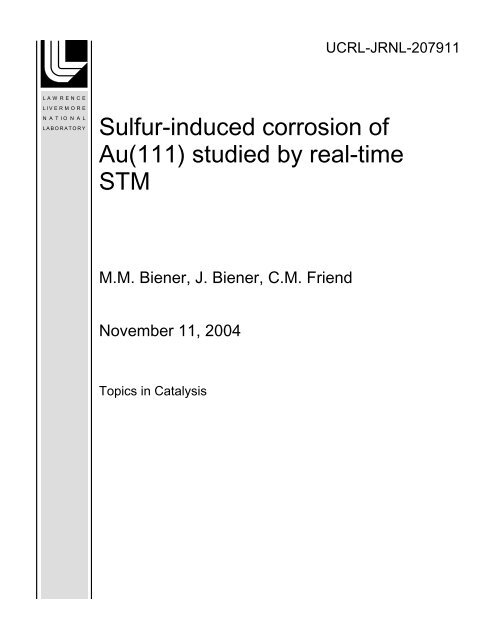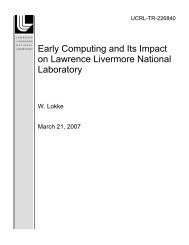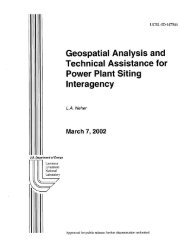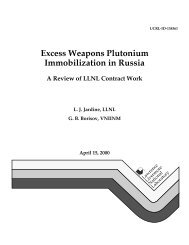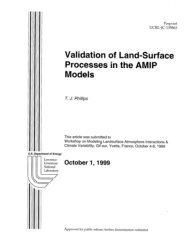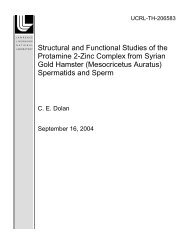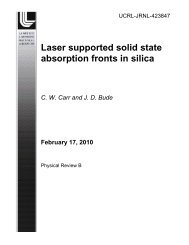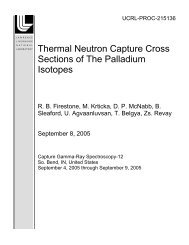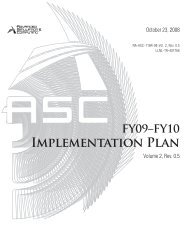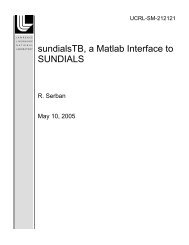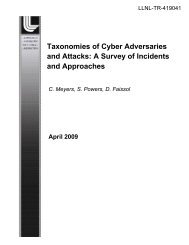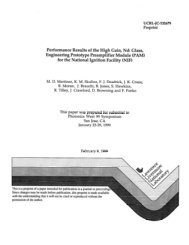Sulfur-induced corrosion of Au(111) studied by real-time STM
Sulfur-induced corrosion of Au(111) studied by real-time STM
Sulfur-induced corrosion of Au(111) studied by real-time STM
Create successful ePaper yourself
Turn your PDF publications into a flip-book with our unique Google optimized e-Paper software.
UCRL-JRNL-207911<br />
<strong>Sulfur</strong>-<strong>induced</strong> <strong>corrosion</strong> <strong>of</strong><br />
<strong>Au</strong>(<strong>111</strong>) <strong>studied</strong> <strong>by</strong> <strong>real</strong>-<strong>time</strong><br />
<strong>STM</strong><br />
M.M. Biener, J. Biener, C.M. Friend<br />
November 11, 2004<br />
Topics in Catalysis
Disclaimer<br />
This document was prepared as an account <strong>of</strong> work sponsored <strong>by</strong> an agency <strong>of</strong> the United States<br />
Government. Neither the United States Government nor the University <strong>of</strong> California nor any <strong>of</strong> their<br />
employees, makes any warranty, express or implied, or assumes any legal liability or responsibility for<br />
the accuracy, completeness, or usefulness <strong>of</strong> any information, apparatus, product, or process<br />
disclosed, or represents that its use would not infringe privately owned rights. Reference herein to any<br />
specific commercial product, process, or service <strong>by</strong> trade name, trademark, manufacturer, or otherwise,<br />
does not necessarily constitute or imply its endorsement, recommendation, or favoring <strong>by</strong> the United<br />
States Government or the University <strong>of</strong> California. The views and opinions <strong>of</strong> authors expressed herein<br />
do not necessarily state or reflect those <strong>of</strong> the United States Government or the University <strong>of</strong> California,<br />
and shall not be used for advertising or product endorsement purposes.
November 02, 2004<br />
To be submitted to JACS<br />
<strong>Sulfur</strong>-<strong>induced</strong> <strong>corrosion</strong> <strong>of</strong> <strong>Au</strong>(<strong>111</strong>) <strong>studied</strong> <strong>by</strong> <strong>real</strong><strong>time</strong><br />
<strong>STM</strong><br />
Monika M. Biener 1,2 , Juergen Biener 3,4 1,2, †<br />
and Cynthia M. Friend<br />
1<br />
Department <strong>of</strong> Chemistry and<br />
2<br />
Division <strong>of</strong> Engineering and Applied Sciences and<br />
3<br />
Center for Imaging and Mesoscale Structures<br />
Harvard University<br />
12 Oxford Street, Cambridge, Massachusetts 02138 USA<br />
4<br />
Nanoscale Synthesis and Characterization Laboratory<br />
Lawrence Livermore National Laboratory<br />
7000 East Ave, Livermore, CA 94550 USA<br />
† <strong>Au</strong>thor to whom correspondence should be sent<br />
Abstract<br />
The interaction <strong>of</strong> sulfur with gold surfaces has attracted considerable interest due<br />
to numerous technological applications such as the formation <strong>of</strong> self-assembled<br />
monolayers (SAMs), use as a <strong>corrosion</strong> inhibitor, and as a chemical sensor. 1-3 In this<br />
work, the interaction <strong>of</strong> sulfur with <strong>Au</strong>(<strong>111</strong>) at two different temperatures (300 K and 420<br />
K) was <strong>studied</strong> <strong>by</strong> <strong>real</strong>-<strong>time</strong> scanning tunnelling microscopy (<strong>STM</strong>), low energy electron<br />
diffraction (LEED) and <strong>Au</strong>ger electron spectroscopy (AES). In the low coverage regime<br />
(< 0.1 monolayer), S modifies the surface stress leading to a lateral expansion <strong>of</strong> the <strong>Au</strong><br />
surface layer. An ordered (√3x√3)R30° sulfur adlayer develops as the coverage reaches<br />
~0.3 ML. With further increasing S coverage the <strong>Au</strong>(<strong>111</strong>) surface undergoes a dynamic<br />
rearrangement while forming a two-dimensional <strong>Au</strong>S phase: gold surface atoms are<br />
removed from regular terrace sites and incorporated into the growing gold sulfide phase<br />
resulting in the appearance <strong>of</strong> pits and irregularly shaped <strong>Au</strong>S islands. Gold sulfide<br />
prepared at room temperature exhibits short-range order; an incommensurate, long-range<br />
ordered <strong>Au</strong>S phase develops upon annealing at 450 – 525 K. Higher temperatures lead to<br />
decomposition <strong>of</strong> the <strong>Au</strong>S <strong>corrosion</strong> film. Formation <strong>of</strong> an ordered <strong>Au</strong>S phase via rapid<br />
step retraction rather than etch pit formation is observed during S-interaction with<br />
<strong>Au</strong>(<strong>111</strong>) surfaces at 420 K. Our results shed new light on the S-<strong>Au</strong>(<strong>111</strong>) interaction.
Introduction<br />
<strong>Au</strong> is an important material in microelectronics due to its high electrical<br />
conductivity in combination with <strong>corrosion</strong> resistance. The noble character <strong>of</strong> <strong>Au</strong> does<br />
not imply a general inability to form stable bonds with non-metals but is rather a<br />
consequence <strong>of</strong> high reaction barriers towards dissociation reactions. 4 However, under<br />
certain circumstances <strong>Au</strong> surfaces can exhibit a high catalytic reactivity, and indeed <strong>Au</strong>based<br />
catalysts are being developed for industrial oxidation processes. 5, 6 The <strong>Au</strong>-S<br />
interaction is probably the most intensively <strong>studied</strong> interaction <strong>of</strong> <strong>Au</strong> surfaces with a nonmetal<br />
as it is important in numerous technological applications: <strong>Au</strong> ore formation, 7 thiolbased<br />
self-assembled monolayers (SAMs), 3, 8, 9 and <strong>corrosion</strong> inhibition, to name only a<br />
few. Furthermore, the increase <strong>of</strong> the electrical resistivity <strong>of</strong> thin gold films upon<br />
adsorption <strong>of</strong> certain sulphur-containing gases can be exploited to design sensors which<br />
allow the detection <strong>of</strong> minute traces <strong>of</strong> those species in gaseous mixtures. 2, 10 However,<br />
an atomic level picture <strong>of</strong> the underlying mechanism for the resistivity change has not<br />
been given yet, although numerous studies on the S/<strong>Au</strong>(<strong>111</strong>) interaction have been<br />
performed in recent years.<br />
A very complex picture <strong>of</strong> the S/<strong>Au</strong>(<strong>111</strong>) interaction has emerged as<br />
demonstrated <strong>by</strong> the variety <strong>of</strong> surface structures formed when S is adsorbed under<br />
different experimental conditions. 1, 11-19 The majority <strong>of</strong> these structures were interpreted<br />
in terms <strong>of</strong> a “classic” surface model, where the positions <strong>of</strong> the <strong>Au</strong> atoms remain<br />
essentially unperturbed upon interaction with S. A common structure is the (√3x√3)R30°<br />
S adlayer with a coverage <strong>of</strong> 0.33 ML 1, 11, 13-15, 18 where sulfur atoms occupy threefoldhollow<br />
sites. This is also a commonly observed structure for alkanethiolate based SAMs<br />
on <strong>Au</strong>(<strong>111</strong>). 3 Ordered arrays <strong>of</strong> rectangular structures were observed at higher S<br />
coverages, 1, 11, 12, 14, 15 which were predominantly attributed to adsorbed S8 species.<br />
In the present study we used <strong>real</strong>-<strong>time</strong> <strong>STM</strong> in combination with low energy<br />
electron diffraction (LEED) and <strong>Au</strong>ger electron spectroscopy (AES) to investigate both<br />
low and high S-coverage regimes. Real-<strong>time</strong> <strong>STM</strong> provides us with nano-scale, <strong>time</strong><br />
resolved information and reveals the very dynamic character <strong>of</strong> the <strong>Au</strong>(<strong>111</strong>) surface upon<br />
interaction with sulfur, such as large-scale mass transport and incorporation <strong>of</strong> <strong>Au</strong> atoms<br />
in a growing <strong>Au</strong>S phase. In view <strong>of</strong> the typically observed inertness <strong>of</strong> <strong>Au</strong> surfaces the S<strong>induced</strong><br />
<strong>corrosion</strong> and mobilization <strong>of</strong> <strong>Au</strong> atoms is surprising and sheds new light on the<br />
nature <strong>of</strong> the <strong>Au</strong>-S interaction.<br />
Experimental<br />
All experiments were performed in an ultrahigh vacuum (UHV) system with a<br />
base pressure <strong>of</strong> 4x10 -10 torr. The system is equipped with a home-made “beetle-type”<br />
<strong>STM</strong> and commercial instrumentation for AES and LEED. The sample was radiatively<br />
heated via a tungsten filament located behind the sample, and the temperature was<br />
monitored <strong>by</strong> a chromel/alumel thermocouple affixed to the sample holder. To account<br />
for the temperature gradient <strong>of</strong> the sample holder versus the crystal a calibration was<br />
performed using a thermocouple directly mounted to the crystal.
The <strong>Au</strong> sample was cleaned <strong>by</strong> cycles <strong>of</strong> Ar + sputtering (1000eV, ~5 µA) at 300<br />
K, followed <strong>by</strong> annealing to 700 K for 10 minutes and 600 K for 60 minutes. This<br />
procedure was repeated several <strong>time</strong>s until no contaminants were detected using AES.<br />
Following this procedure, the characteristic <strong>Au</strong>(<strong>111</strong>)-(22x√3) “herringbone”<br />
reconstruction was observed <strong>by</strong> LEED and <strong>STM</strong>. The <strong>Au</strong> sample used for the<br />
experiments <strong>of</strong> the present study exhibits many surface defects (see fig. 1 and 4), most<br />
likely partial Shockley dislocations 20 introduced <strong>by</strong> the gentle annealing procedures.<br />
SO2 (Matheson, anhydyrous grade) served as a source <strong>of</strong> sulfur, and was<br />
introduced using a leak valve such that a steady-state chamber pressure <strong>of</strong> 2x10 -7 torr was<br />
maintained. Gas lines were evacuated before each dose. All exposures are given in<br />
uncorrected ion gauge readings using units <strong>of</strong> Langmuir (1L=10 -6 torr•s). Only a small<br />
fraction <strong>of</strong> the SO2 molecules that impinge on the surface decomposes and deposits<br />
sulfur. The sulfur coverage was monitored <strong>by</strong> AES and calibrated relative to the<br />
(√3x√3)R30° LEED pattern which corresponds to a S coverage <strong>of</strong> 0.33 ML. The<br />
exposure <strong>of</strong> the surface to SO2 was interrupted at various <strong>time</strong>s and the surface examined<br />
using AES. The only species detected on the surface at all <strong>time</strong>s was sulphur; oxygen, if<br />
any, was below the detection limit <strong>of</strong> AES. The oxygen released <strong>by</strong> SO2 decomposition<br />
seems to be removed via an abstraction reaction with excess SO2. 21 In order to rule out<br />
effects due to electron-<strong>induced</strong> reactions, the experiments were reproduced with the ion<br />
gauge turned <strong>of</strong>f.<br />
All <strong>STM</strong> images shown in this work were collected at room temperature or 420 K<br />
(if indicated) using Pt0.8 Ir0.2 tips. The tunneling bias was set in the range <strong>of</strong> +60 mV to<br />
+1.0 V. The <strong>STM</strong> scanner was calibrated against the unit cell <strong>of</strong> the <strong>Au</strong>(<strong>111</strong>) surface.<br />
Real-<strong>time</strong> <strong>STM</strong> images were collected during continuous SO2 exposure. We observe the<br />
same S <strong>induced</strong> changes irrespective <strong>of</strong> whether the SO2 exposure was prior to or during<br />
scanning.<br />
Results and Discussion<br />
The dynamic rearrangement <strong>of</strong> <strong>Au</strong>(<strong>111</strong>) surfaces with increasing S coverage at<br />
room temperature was captured <strong>by</strong> <strong>real</strong>-<strong>time</strong> <strong>STM</strong> imaging. The sequence <strong>of</strong> images<br />
displayed in figure 1 reveals a lifting <strong>of</strong> the herringbone reconstruction in the low S<br />
coverage regime followed <strong>by</strong> the formation <strong>of</strong> a 2D <strong>Au</strong>S phase at higher S coverages.<br />
The clean <strong>Au</strong>(<strong>111</strong>) surface exhibits a characteristic reconstruction pattern (fig. 1a, insert)<br />
that is caused <strong>by</strong> the incorporation <strong>of</strong> an additional 4% <strong>of</strong> <strong>Au</strong> atoms in the surface layer to<br />
reduce the tensile surface stress as described in detail elsewhere. 22, 23 This <strong>Au</strong>(<strong>111</strong>)-<br />
(√3x22) herringbone reconstruction is also signified <strong>by</strong> the presence <strong>of</strong> characteristic<br />
satellites spots in the LEED pattern shown in figure 2a. 24<br />
The surface stress <strong>of</strong> the clean <strong>Au</strong>(<strong>111</strong>) surface is modified upon sulfur<br />
adsorption. As a consequence, the herringbone reconstruction is lifted, even at S<br />
coverages as low as 0.1 ML. <strong>Au</strong> atoms, which are expelled during the surface relaxation,
agglomerate at the step edges thus causing a serrated (wavy) step-edge appearance (fig.<br />
1b). Simultaneously the satellite spots in the LEED pattern associated with the<br />
herringbone structure disappear (fig 2b). The ejection <strong>of</strong> <strong>Au</strong> atoms revealed <strong>by</strong> <strong>STM</strong><br />
indicates that S adsorption reverses the surface stress from tensile to compressive.<br />
The origin <strong>of</strong> adsorbate-<strong>induced</strong> compressive surface stress can be understood in<br />
terms <strong>of</strong> a charge transfer from substrate surface bonds to the adsorbate atoms. 25 This in<br />
turn drives the ejection <strong>of</strong> <strong>Au</strong> atoms, which agglomerate at ascending step edges.<br />
Diffusion across descending steps at room temperature is hindered <strong>by</strong> the existence <strong>of</strong> a<br />
“Schwoebel” barrier. The amount <strong>of</strong> <strong>Au</strong> atoms as judged <strong>by</strong> the observed change in the<br />
step edge position during sulfur adsorption is consistent with the expected amount <strong>of</strong><br />
ejected <strong>Au</strong> atoms (4%). The lifting <strong>of</strong> the <strong>Au</strong>(<strong>111</strong>) reconstruction <strong>by</strong> small amounts <strong>of</strong><br />
strongly (specifically) adsorbed anions is also a common observation in electrochemical<br />
environments. 26<br />
An ordered (√3x√3)R30° sulfur adlayer develops as the S coverage approaches<br />
~0.3 ML as inferred from the observation <strong>of</strong> a well-defined (√3x√3)R30° LEED pattern.<br />
As the LEED pattern develops, fractional-order spot-splitting is observed (figure 2c).<br />
Splitting <strong>of</strong> fractional-order spots can be explained <strong>by</strong> ordered arrays <strong>of</strong> antiphase<br />
domains 27 , where the amount <strong>of</strong> splitting correlates with the domain size. The amount <strong>of</strong><br />
splitting in our case corresponds to a (5x5) superlattice <strong>of</strong> the (√3x√3)R30° structure. The<br />
fractional-order spot-splitting disappears as the S coverage approaches 0.33 ML (fig. 2d).<br />
The (√3x√3)R30° S adlayer observed <strong>by</strong> LEED is not observed using <strong>STM</strong>.<br />
Instead, atomically-resolved images <strong>of</strong> the <strong>Au</strong> surface were repeatedly obtained (figure<br />
2c inset). These data indicate that the sulfur in the (√3x√3)R30° adlayer is too mobile to<br />
be imaged under the tunneling conditions used in the present work (see experimental).<br />
This is consistent with the streaky appearance <strong>of</strong> the <strong>STM</strong> images obtained in this<br />
coverage regime. A similar result was reported for K and Na (√3x√3)R30° adlayer phases<br />
on <strong>Au</strong>(<strong>111</strong>). 28, 29 However, the <strong>Au</strong>(<strong>111</strong>)-(√3x√3)R30°-S phase has been imaged <strong>by</strong> <strong>STM</strong><br />
1, 11, 14, 15<br />
in an electrochemical environment.<br />
Upon further increasing sulfur coverage we observe a dynamic surface<br />
restructuring caused <strong>by</strong> formation <strong>of</strong> a 2D <strong>Au</strong>S phase (figure 1d-f): small irregularly<br />
shaped islands start to nucleate, preferentially at defects, and monoatomic etch pits<br />
develop. Both pits and islands appear on terraces, and their density increases with<br />
increasing S-coverage (Fig. 1e). These observations indicate that there is massive mass<br />
transport: <strong>Au</strong> atoms are removed from regular terrace sites, there<strong>by</strong> creating pits, and<br />
incorporated into the growing <strong>Au</strong>S phase. Finally the surface is completely covered with<br />
a 2D gold sulfide phase (Fig.1f) which exhibits a sponge-like morphology and passivates<br />
the <strong>Au</strong> surface against further <strong>corrosion</strong>. The S saturation coverage is 0.6 ML. The<br />
(√3x√3)R30° LEED pattern disappears (figure 2e) upon the formation <strong>of</strong> the first<br />
clusters, and a diffuse LEED pattern indicating missing long-range order is obtained.<br />
The appearance <strong>of</strong> etch pits suggests that S continues to weaken the <strong>Au</strong>-<strong>Au</strong> bonds<br />
with increasing S coverage, finally reaching a point where the energy necessary to
emove <strong>Au</strong> atoms from regular lattice sites is overcompensated <strong>by</strong> the energy released <strong>by</strong><br />
the formation <strong>of</strong> mobile <strong>Au</strong>-S species. This demonstrates that the <strong>Au</strong>-S bond is strong<br />
enough to drive the <strong>corrosion</strong> <strong>of</strong> <strong>Au</strong>. Indeed, stable gold sulfide clusters (<strong>Au</strong>2S)n, n = 1, 2,<br />
have been identified <strong>by</strong> ab initio calculations. 30 It is interesting that a preferred etching <strong>of</strong><br />
<strong>Au</strong> step-edge atoms is not observed (see below).<br />
The mobilization <strong>of</strong> <strong>Au</strong> surface atoms <strong>by</strong> the interaction with sulfur or sulfurcontaining<br />
molecules seems to be a general phenomenon: For example, the formation <strong>of</strong><br />
2D vacancy islands <strong>of</strong> monoatomic depth has also been observed during the preparation<br />
<strong>of</strong> alkanethiol-based SAMs on <strong>Au</strong>(<strong>111</strong>). 8, 9, 31, 32 The driving force for the formation <strong>of</strong><br />
these structures was, however, not clear; it was speculated that the vacancies may be<br />
related to a thiol-<strong>induced</strong> surface restructuring that enhances the <strong>Au</strong> surface diffusion<br />
rate. Mobilization <strong>of</strong> <strong>Au</strong> atoms and vacancy formation has also been observed during the<br />
interaction <strong>of</strong> cysteine with <strong>Au</strong>(110) surfaces. 33<br />
Significant changes in the surface topography are observed upon annealing: the<br />
sponge-like <strong>Au</strong>S phase formed at room temperature is transformed into an ordered twodimensional<br />
<strong>Au</strong>S phase which produces a very complex, but well-defined LEED pattern<br />
(figure 2e). Simultaneously, large vacancy islands <strong>of</strong> monoatomic depth develop <strong>by</strong><br />
Ostwald ripening <strong>of</strong> the irregular etch pits created during formation <strong>of</strong> the <strong>Au</strong>S phase at<br />
room temperature. Figure 3 shows the changes in the surface morphology as a function <strong>of</strong><br />
the annealing temperature. Ring-like structures with some short-range order are observed<br />
after annealing to 420 K, and long-range order develops during annealing to 450 K. The<br />
growing vacancy islands are <strong>of</strong> monoatomic depth and both terraces and vacancy islands<br />
are uniformly covered <strong>by</strong> the <strong>Au</strong>S phase, based on the fact that the <strong>STM</strong> images are the<br />
same in vacancies and on terraces. The development <strong>of</strong> long-range order is further<br />
emphasized <strong>by</strong> the observation <strong>of</strong> a well-defined, complex LEED pattern (figure 2e).<br />
The well-ordered <strong>Au</strong>S overlayer obtained after annealing exhibits a 1:1<br />
stoichiometry: AES indicates a sulfur coverage <strong>of</strong> 0.5 ML, i.e. the sulfur coverage<br />
decreases <strong>by</strong> ~20% during annealing, in excellent agreement with the results obtained <strong>by</strong><br />
a radioactive 35 S tracer-technique; 16, 17 the number <strong>of</strong> <strong>Au</strong> atoms incorporated in the 2D<br />
<strong>Au</strong>S phase was estimated to be 0.5 ML <strong>by</strong> determining the surface area covered <strong>by</strong><br />
vacancy islands.<br />
High-resolution <strong>STM</strong> images <strong>of</strong> the ordered 2D <strong>Au</strong>S phase reveal a quasirectangular<br />
unit cell, with lattice parameters <strong>of</strong> (8.8 ± 0.4) x (8.2 ± 0.4) Å 2 and an angle<br />
<strong>of</strong> 82° ± 4° between the lattice vectors (Figure 3e).The complex LEED pattern (figure 2f)<br />
is consistent with the <strong>STM</strong> results and can be interpreted in terms <strong>of</strong> an incommensurate<br />
<strong>Au</strong>S phase with a quasi-rectangular unit cell and 6 rotational domains. The orientation <strong>of</strong><br />
one unit cell axes is rotated <strong>by</strong> ~7 degrees relative to the [110] direction <strong>of</strong> the <strong>Au</strong><br />
substrate. This is consistent with the arrangement <strong>of</strong> rotational domains to each other as<br />
observed <strong>by</strong> <strong>STM</strong>. Interestingly, an early study reported a similar LEED pattern from<br />
16, 17<br />
<strong>Au</strong>(<strong>111</strong>) surfaces treated with H2S/H2 gas mixtures at elevated temperatures.
The ordered <strong>Au</strong>S phase described above seems to be a favorable configuration as<br />
very similar sulfur-<strong>induced</strong> surface structures on <strong>Au</strong>(<strong>111</strong>) have been prepared <strong>by</strong><br />
electrooxidation in aqueous solutions <strong>of</strong> Na2S or H2S at room temperature. 1, 11, 12, 14, 15 The<br />
interpretation <strong>of</strong> these rectangular surface features is controversial although a model <strong>of</strong><br />
adsorbed S8 molecules was preferred <strong>by</strong> the majority <strong>of</strong> authors. However, the S-<strong>induced</strong><br />
mobilization <strong>of</strong> <strong>Au</strong> atoms revealed <strong>by</strong> the present study clearly rules out a simple sulfur<br />
adlayer model.<br />
In contrast to the UHV experiments presented here the ordered <strong>Au</strong>S phase<br />
develops without annealing in an electrochemical environment thus suggesting an<br />
increased surface mobility under these conditions. An anion-enhanced surface mobility is<br />
a common phenomenon in electrochemistry, and is indeed the basis <strong>of</strong> the so-called<br />
electrochemical annealing. 26, 34 It has been suggested that the increased mobility <strong>of</strong> <strong>Au</strong><br />
surface atoms is caused <strong>by</strong> the anion-<strong>induced</strong> weakening <strong>of</strong> <strong>Au</strong>-<strong>Au</strong> surface bonds. This<br />
effect is more pronounced the more positive the potential and/or the stronger the anion-<br />
<strong>Au</strong> interaction. 26 Since the <strong>Au</strong>-S interaction is very strong, as demonstrated <strong>by</strong> the<br />
observed etching, it is not surprising that the ordered <strong>Au</strong>S phase can be formed in an<br />
electrochemical environment even at room temperature. However, the mass transport<br />
involved in the S-<strong>Au</strong>(<strong>111</strong>) interaction has not been reported earlier, and the majority <strong>of</strong> S<strong>induced</strong><br />
surface structures were consequently interpreted in terms <strong>of</strong> a simple adlayer<br />
surface model, where the positions <strong>of</strong> the <strong>Au</strong> atoms remain essentially unperturbed upon<br />
interaction with S.<br />
The dynamic rearrangement <strong>of</strong> the <strong>Au</strong> surface upon interaction with S was further<br />
investigated <strong>by</strong> <strong>real</strong>-<strong>time</strong> scanning at 420 K. Figure 4 shows a series <strong>of</strong> <strong>STM</strong> images<br />
collected from a <strong>Au</strong>(<strong>111</strong>) surface as a function <strong>of</strong> increasing S coverage at 420 K. Using<br />
a defect (see arrow in fig. 4a) as reference point allows us to track changes in the step<br />
edge morphology during interaction with S. In the low coverage regime, the S-<strong>induced</strong><br />
surface modifications are very similar to those observed during the corresponding room<br />
temperature experiments: the herringbone reconstruction is lifted, and <strong>Au</strong> atoms are<br />
ejected and agglomerate at step edges. Diffusion along step edges is fast at 420 K, and<br />
thus the step edges remain relatively straight (fig 4b), in contrast to the serrated step edge<br />
morphology observed during room temperature experiments (fig 1b). However, in the<br />
high coverage regime (~0.3 ML to ~0.5 ML) we detect a sudden retraction <strong>of</strong> step edges<br />
(figures 4c-f) rather than the etch pit and island formation observed at RT. After the stepedge<br />
position becomes stable again, indicating equilibrium, a S coverage <strong>of</strong> 0.5 ML was<br />
measured <strong>by</strong> AES (at 420 K). Despite missing evidence for <strong>Au</strong>S formation at 420K<br />
(except <strong>Au</strong> mobilization evidenced <strong>by</strong> step-retraction), the long-range ordered <strong>Au</strong>S phase<br />
described above is observed via LEED and <strong>STM</strong> after cooling the sample to room<br />
temperature (data not shown).<br />
The sudden retraction <strong>of</strong> steps upon reaching a sulfur coverage <strong>of</strong> ~0.3 ML at 420<br />
K is in contrast to the development <strong>of</strong> etch pits and islands at 300 K. The appearance <strong>of</strong><br />
etch pits at 300 K indicates that <strong>Au</strong> atoms are pulled out <strong>of</strong> regular terrace sites, driven <strong>by</strong><br />
the formation <strong>of</strong> stable <strong>Au</strong>S complexes which then nucleate to form irregularly shaped<br />
<strong>Au</strong>S islands. In contrast, at 420 K <strong>Au</strong> atoms in the surface layer seem to be mobile<br />
enough to annihilate any arising vacancy structure on the <strong>time</strong> scale <strong>of</strong> the experiment (~
2 min per frame), which leads to the impression <strong>of</strong> retracting step-edges. An alternative<br />
explanation would be that <strong>Au</strong> atoms are indeed supplied from weaker bound step edges<br />
sites. In this case, the absence <strong>of</strong> preferred step-edge etching at room temperature would<br />
indicate step-edge passivation <strong>by</strong> adsorbed <strong>Au</strong>S species or, alternatively, the development<br />
<strong>of</strong> a sulphur depletion zone at the step edge (diffusion-limited reaction regime).<br />
The fate <strong>of</strong> the <strong>Au</strong> atoms which were removed from regular surface sites, but not<br />
detected as <strong>Au</strong>S islands as in the case <strong>of</strong> the room temperature experiment also needs to<br />
be considered. Since the amount <strong>of</strong> missing <strong>Au</strong> atoms is certainly too high to be<br />
explained in terms <strong>of</strong> mobile <strong>Au</strong> adatoms, we conclude that mobile <strong>Au</strong>S complexes are<br />
formed at 420 K. Upon cooling to room temperature a liquid-solid phase transition seems<br />
to take place. Alternatively, a coverage dependent liquid-solid phase transition could take<br />
place at 420 K, but this would require that the phase transition happens between two<br />
scans as otherwise we would have observed intermediate stages <strong>of</strong> the transition.<br />
Anyway, the ordered <strong>Au</strong>S thus obtained is identical to the <strong>Au</strong>S phase formed <strong>by</strong> room<br />
temperature reaction and subsequent annealing.<br />
A quantitative analysis <strong>of</strong> the <strong>STM</strong> images shown in figure 4 reveals that the steps<br />
retract <strong>by</strong> ~ 0.5 ML equivalents (integrated area over the displacement <strong>of</strong> the step edges<br />
during S exposure). This is in excellent agreement with the surface area covered <strong>by</strong><br />
vacancy islands after <strong>Au</strong>S formation at room temperature (figure 3c), and further<br />
corroborates our statement that 0.5 ML <strong>Au</strong> atoms are incorporated in the <strong>Au</strong>S phase.<br />
The <strong>Au</strong>S phase is stable up to a temperature <strong>of</strong> ~ 525 K. During formation <strong>of</strong> the<br />
ordered <strong>Au</strong>S phase in the temperature range from 450 K to 525 K, the S coverage<br />
decreases <strong>by</strong> approx. 20% from 0.6 ML to 0.5 ML. Higher annealing temperatures cause<br />
a rapid decrease <strong>of</strong> the sulphur coverage. Simultaneously the well-defined LEED pattern<br />
(figure 2e) becomes diffuse. Figure 5 shows the S coverage as determined <strong>by</strong> the<br />
S150/<strong>Au</strong>239 AES peak ratio versus annealing temperature.The sample was annealed for 20<br />
minutes at each temperature and subsequently AE spectra were collected at room<br />
temperature. The loss <strong>of</strong> sulfur is most likely caused <strong>by</strong> the decomposition <strong>of</strong> the <strong>Au</strong>S<br />
<strong>corrosion</strong> film, rather than desorption <strong>of</strong> <strong>Au</strong>S units. Indeed, it has been reported that <strong>Au</strong>2S<br />
decomposes into <strong>Au</strong> and S at temperatures above 490 K. 35<br />
Our results provide an atomic level picture <strong>of</strong> the working principle <strong>of</strong> <strong>Au</strong>-based<br />
sensors 10 for S containing gas species: a 2D <strong>Au</strong>S <strong>corrosion</strong> film is formed via massive<br />
mass transport at room temperature and decomposes above 525 K there<strong>by</strong> restoring the<br />
sensing capacity. The <strong>Au</strong>S forms a pure 2D phase as it passivates the surface against<br />
further <strong>corrosion</strong>. This suggests that sensors with an enhanced sensitivity can be<br />
developed on the basis <strong>of</strong> nanoporous gold as this material exhibits a very high surface to<br />
volume ratio.<br />
Conclusion<br />
The results presented provide new insight into the S-<strong>Au</strong>(<strong>111</strong>) interaction. <strong>Sulfur</strong> interacts<br />
strongly with the <strong>Au</strong>(<strong>111</strong>) surface which leads to stress relaxation in the low S-coverage<br />
regime and <strong>corrosion</strong> involving a dynamic surface restructuring in the high S coverage
egime. Specifically, S adsorption lifts the herringbone reconstruction <strong>of</strong> the <strong>Au</strong>(<strong>111</strong>)<br />
surface even at a S coverage as low as 0.1 ML. The lifting <strong>of</strong> the herringbone<br />
reconstruction can be explained <strong>by</strong> a S-<strong>induced</strong> weakening <strong>of</strong> <strong>Au</strong>-<strong>Au</strong> surface bonds,<br />
which causes a lateral expansion <strong>of</strong> the <strong>Au</strong> surface layer. This reverses the surface stress<br />
from tensile to compressive as revealed <strong>by</strong> the ejection <strong>of</strong> <strong>Au</strong> atoms. As the S coverage<br />
approaches ~0.3 ML, an ordered (√3x√3)R30° sulfur adlayer develops. The S-<strong>induced</strong><br />
weakening <strong>of</strong> <strong>Au</strong>-<strong>Au</strong> surface bonds continues with further increasing S coverage, which<br />
finally leads to the <strong>corrosion</strong> <strong>of</strong> the <strong>Au</strong> surface: gold surface atoms are removed from<br />
regular terrace sites and incorporated into the growing two-dimensional <strong>Au</strong>S phase<br />
resulting in the appearance <strong>of</strong> etch pits and irregularly shaped <strong>Au</strong>S islands. The<br />
development <strong>of</strong> the 2D <strong>Au</strong>S phase passivates the <strong>Au</strong> surface against further <strong>corrosion</strong>.<br />
Long-range order develops upon annealing at 450 – 525 K, higher temperatures lead to<br />
decomposition <strong>of</strong> the <strong>Au</strong>S <strong>corrosion</strong> film. A smooth, long-range ordered <strong>Au</strong>S phase<br />
without vacancy island structures can be prepared <strong>by</strong> S-interaction with <strong>Au</strong>(<strong>111</strong>) surfaces<br />
at 420 K.<br />
Acknowledgements:<br />
We gratefully acknowledge the support <strong>of</strong> this work <strong>by</strong> Harvard University<br />
NSEC, funded <strong>by</strong> the National Science Foundation, grant no. PHY-01-17795.<br />
J. B. acknowledges current support under the auspices <strong>of</strong> the U. S. Department <strong>of</strong> Energy<br />
<strong>by</strong> the University <strong>of</strong> California, Lawrence Livermore National Laboratory, under<br />
Contract No. W-7405-Eng-48.<br />
Figure captions<br />
Figure 1: Real-<strong>time</strong> <strong>STM</strong> images capturing the dynamics <strong>of</strong> the S-<strong>induced</strong> <strong>Au</strong> <strong>corrosion</strong><br />
at room temperature. (a) clean <strong>Au</strong>(<strong>111</strong>) surface exhibiting the typical herringbone<br />
reconstruction pattern (insert, 90 x 50 nm 2 ) caused <strong>by</strong> a 4% compression <strong>of</strong> the surface<br />
layer. (b) Even a small sulfur coverage (≤ 0.1 ML) reverses the surface stress from tensile<br />
to compressive and there<strong>by</strong> drives the ejection <strong>of</strong> <strong>Au</strong> atoms. As a consequence the<br />
herringbone reconstruction is lifted (see insert, 75 x 40 nm 2 ). The ejected <strong>Au</strong> atoms<br />
agglomerate at ascending step edges leading to a serrated step edge appearance. (c) The<br />
unreconstructed <strong>Au</strong>(<strong>111</strong>) surface is stable up to a S coverage <strong>of</strong> ~ 0.3 ML, where S forms<br />
an ordered (√3x√3)R30° adlayer, which is transparent for <strong>STM</strong> (see atomically resolved<br />
<strong>Au</strong> surface in inset (2.6 x 1.5 nm 2 )), but evident <strong>by</strong> LEED (fig. 2d ). Early stages <strong>of</strong> the S<strong>induced</strong><br />
<strong>Au</strong> <strong>corrosion</strong>: (d) monoatomic etch pits and small <strong>Au</strong>S clusters appear on<br />
terraces, and (e) their density increases with increasing S-coverage. (f) At a sulfur<br />
coverage <strong>of</strong> ~0.6 ML the <strong>Au</strong> surface is covered with a sponge-like gold sulfide phase<br />
which passivates the surface against further <strong>corrosion</strong>.
Figure 2: Monitoring the S-<strong>induced</strong> <strong>corrosion</strong> <strong>of</strong> <strong>Au</strong>(<strong>111</strong>) <strong>by</strong> LEED: (a) clean,<br />
reconstructed <strong>Au</strong>(<strong>111</strong>) surface exhibiting the satellites <strong>of</strong> the <strong>Au</strong>(1,1) spots associated<br />
with the herringbone reconstruction. (b) The satellites disappear even at a low sulfur<br />
coverage (≤ 0.1 ML). (c) A (√3x√3)R30° pattern with split fractional-order spots<br />
develops, and (d) transforms into a regular (√3x√3)R30° pattern at a S-coverage <strong>of</strong> 0.33<br />
ML. (e) With further increasing S coverage the LEED pattern becomes diffuse (0.33 ML<br />
< θS ≤ 0.6 ML). (f) The well-defined complex LEED pattern observed after annealing to<br />
450 K indicates the formation <strong>of</strong> an incommensurate <strong>Au</strong>S phase with long-range order<br />
(θS ~ 0.5 ML). All LEED images were obtained at an electron beam energy <strong>of</strong> 68 eV.<br />
Figure 3: The morphology <strong>of</strong> the sponge-like <strong>Au</strong>S phase formed at room temperature<br />
(fig 1f) changes upon annealing. <strong>STM</strong> images were collected at room temperature after<br />
10 min <strong>of</strong> annealing at 380 K (a), 420 K (b,c), and 450 K (d,e), respectively. With<br />
increasing annealing temperature, the original irregular etch pits transform into<br />
increasingly larger vacancy islands <strong>of</strong> monoatomic depth (Oswald ripening). Independent<br />
<strong>of</strong> the annealing temperature, the vacancy islands cover ~50% <strong>of</strong> the surface area,<br />
indicating the incorporation <strong>of</strong> ~0.5 ML <strong>of</strong> <strong>Au</strong> atoms into the 2D <strong>Au</strong>S phase. (c) After<br />
annealing to 420 K, some locally ordered arrays <strong>of</strong> quasi-rectangular structures can be<br />
observed <strong>by</strong> high-resolution <strong>STM</strong>. (e) Long-range order develops during annealing at 450<br />
K. The <strong>Au</strong>S phase uniformly covers both vacancy islands and terrace areas.<br />
Figure 4: Dynamic restructuring <strong>of</strong> the surface landscape upon interaction with S at 420<br />
K, monitored <strong>by</strong> <strong>real</strong>-<strong>time</strong> <strong>STM</strong>: A surface defect (marked <strong>by</strong> the straight line) is used as<br />
reference point to track changes in the step morphology with respect to the original step<br />
edge structure (dashed lines), and to correct for the thermal drift <strong>of</strong> the experiment (note<br />
the lateral translation <strong>of</strong> the dashed lines in the different frames). (a) Clean <strong>Au</strong>(<strong>111</strong>)<br />
surface. (b) <strong>Sulfur</strong> lifts the reconstruction <strong>of</strong> the <strong>Au</strong> surface: the additional <strong>Au</strong> atoms<br />
incorporated in the reconstruction (4%) are ejected and agglomerate at ascending steps as<br />
evidenced <strong>by</strong> the outward flow <strong>of</strong> the steps. (c,d,e) With increasing S-coverage (0.3 ML<br />
to 0.5 ML) the steps suddenly retract indicating the removal <strong>of</strong> <strong>Au</strong> atoms from the surface<br />
layer and formation <strong>of</strong> a “liquid” <strong>Au</strong>S phase which is not visible in <strong>STM</strong> under the<br />
conditions <strong>of</strong> our experiments.<br />
Figure 5: The amount <strong>of</strong> S incorporated in the 2D <strong>Au</strong>S phase (prepared at room<br />
temperature) versus annealing temperature, as determined <strong>by</strong> the S150/<strong>Au</strong>239 AES peak<br />
ratio (calibrated against the (√3x√3)R30° S adlayer with a S coverage <strong>of</strong> 0.33 ML). The<br />
sample was annealed for 20 minutes at each temperature and AE spectra were<br />
subsequently recorded at room temperature. Development <strong>of</strong> the long-range ordered <strong>Au</strong>S<br />
phase in the temperature range from 450 K to 525 K is accompanied <strong>by</strong> a decrease <strong>of</strong> the<br />
S coverage <strong>of</strong> approx. 20%. Higher annealing temperatures lead to a rapid loss <strong>of</strong> sulfur,<br />
most likely caused <strong>by</strong> <strong>Au</strong>S decomposition.
References<br />
(1) Vericat, C., Vela M. E., Andreasen G., Salvarezza R. C., Vazquez L. and Martin-<br />
Gago J. A., Langmuir 2001, 17, 4919-4924.<br />
(2) Yoo, K. S., Sorensen I. W. and Glaunsinger W. S., J. Vac. Sci. Technol. A 1994,<br />
12, 192-198.<br />
(3) Ulman, A., Chem. Rev. 1996, 96, 1533-1554.<br />
(4) Hammer, B. and Norskov J. K., Nature 1995, 376, 238.<br />
(5) Valden, M., Lai X. and Goodman D. W., Science 1998, 281, 1647-1650.<br />
(6) Haruta, M., Catal. Today 1997, 36, 153-166.<br />
(7) Phillips, G. N. and Evans K. A., Nature 2004, 429, 860.<br />
(8) Poirier, G. E., Langmuir 1997, 13, 2026.<br />
(9) Poirier, G. E., Chem. Rev. 1997, 97, <strong>111</strong>7.<br />
(10) U.S. Patent No. 4724008, (Arizona Instrument Corporation, 1988)<br />
(11) Vericat, C., Andersen J. N., Vela M. E. and Salvarezza R. C., J. Phys. Chem. B<br />
2000, 104, 302-307.<br />
(12) McCarley, R. L., Kim Y. T. and Bard J., J. Phys. Chem. 1992, 97, 211.<br />
(13) Martin, H., Vericat C., Andreasen G., Creus A. H., Vela M. E. and Salvarezza R.<br />
C., Langmuir 2001, 17, 2334-2339.<br />
(14) Vericat, C., Vela M. E., Andreasen G. A. and Salvarezza R. C., Phys. Rev. Lett.<br />
2003, 90, 075506.<br />
(15) Gao, X., Zhang Y. and Weaver M. J., J. Phys. Chem. 1992, 96, 4156.<br />
(16) Kostelitz, M. and Oudar J., Surf. Sci 1971, 27, 176.<br />
(17) Kostelitz, M., Domange J. L. and Oudar J., Surf. Sci. 1972, 34, 431-449.<br />
(18) Rodriguez, J. A., Dvorak J., Jirsak T., Gang L., Hrbek J., Aray Y. and Gonzalez<br />
C., J. Am. Chem. Soc. 2002, 125, 276-285.<br />
(19) Touzov, I. and Gorman C. B., Langmuir 1997, 13, 4850.<br />
(20) de la Fuente, O. R., Zimmerman J. A., Gonzalez M. A., de la Figuera J., Hamilton<br />
J. C., Pai W. W. and Rojo J. M., Phys. Rev. Lett. 2002, 8803, 6101.<br />
(21) Biener, M. M., Biener J. and Friend C. M., in preparation<br />
(22) Woell, C., Chiang R. J., Wilson J. and Lippel P. H., Phys. Rev. B 1989, 39, 7988.<br />
(23) Barth, J. V., Brune H., Ertl G. and Behm R. J., Phys. Rev. B 1990, 42, 9307.<br />
(24) Murty, M. V. R., Curcic T., Judy A. and Cooper B. H., Phys. Rev. B 1999, 60,<br />
16956.<br />
(25) Ibach, H., Surf. Sci. Rep. 1997, 29, 193.<br />
(26) Kolb, D. M., Prog. Surf. Sci. 1996, 51, 109.<br />
(27) Van Hove, M. A., Weinberg W. H. and Chan C. M., Low-Electron Energy<br />
Diffraction (Springer-Verlag, 1986).<br />
(28) Barth, J. V., Behm R. J. and Ertl G., Surf. Sci. Lett. 1993, 302, L319-L324.<br />
(29) Barth, J. V., Schuster R., Behm R. J. and Ertl G., Surf. Sci. 1995, 348, 280.<br />
(30) Bagaturyants, A. A., Safonov A. A., Stoll H. and Werner H. J., J. Chem. Phys.<br />
1998, 109, 3096.<br />
(31) Poirier, G. E. and Pylant E. D., Science 1996, 272, 1145.<br />
(32) Chailapakul, O., Sun L., Xu C. and Crooks R. M., J. Am. Chem. Soc. 1993, 115,<br />
12459.
(33) Kuehnle, A., Linderoth T. R., Hammer B. and Besenbacher F., Nature 2002, 415,<br />
891.<br />
(34) Kolb, D. M., Surf. Sci. 2001, 500, 722.<br />
(35) Ishikawa, K., Isonaga T., Wakita S. and Suzuki Y., Solid State Ionics 1995, 79,<br />
60.
Fig. 1<br />
(a) (b)<br />
(c) (d)<br />
(e)<br />
50 nm 50 nm<br />
50 nm<br />
50 nm<br />
(f)<br />
50 nm<br />
50 nm
Fig. 2<br />
(a) (b)<br />
(c) (d)<br />
(e) (f)<br />
+ 450
Fig. 3<br />
(a)<br />
380 K<br />
(b)<br />
420 K<br />
(d)<br />
50 nm<br />
50 nm<br />
(c)<br />
420 K<br />
(e)<br />
450 K<br />
2.5 nm<br />
450 K 100 nm<br />
2.5 nm
Fig. 4<br />
50 nm<br />
(a)<br />
(b)<br />
(c) (d)<br />
(e)
Fig. 5<br />
S coverage [ML]<br />
0.6<br />
0.4<br />
0.2<br />
0.0<br />
300 400 500 600 700 800<br />
temperature [K]
TOC image:


